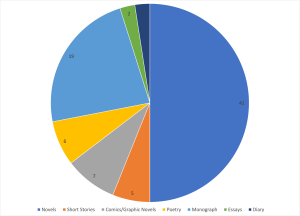For reasons that I probably don’t need to articulate, I was a bit distracted from things like posting here at the end of last year. The general idea of this blog is to draw attention to things that might seem unworthy of that attention— minor, mundane, marginal— and try to draw our what makes them interesting, to me. In a moment when there is more than enough going on that is obviously both important and urgent, the kinds of things I tend to write about here seem especially trivial, or like a misuse of finite cognitive resources. And since I definitely don’t want to focus on how things are falling apart, I just don’t post. But part of me also thinks this is precisely the wrong response; that when power is in the hands of such people— people who hate complexity and weirdness and nuance, people who are vulgar and violent and cruel, people who are ignorant and proud of their ignorance, people for whom the lowest common denominator is the only standard— that paying attention in this way is even more worthwhile. I don’t want to make it sound like I think posting links to a blog is a meaningful act of resistance— it’s not— but maybe it can be something of a salve to be reminded that reality is fractal, and there is always more going on that you can see from any one angle.
Anyway. I have quite a backlog, so I’m going to say very little (for me) about each of these.
First, here is a list of my favorite albums from 2024. I know it’s very late for this kind of thing, but it’s not like music goes out of date.
“Writing in Pictures,” by Chris Ware
Chris Ware profiles the author and illustrator Richard Scarry, getting at what is so fascinating and magical about his work. The piece also offers a brief glimpse into mid-century children’s book publishing, which turns out to offer yet another example of how America has benefitted from offering refuge to people who need it— which of course does not offer any kind of lesson about anything going on today.
“The Future is Too Easy“, by David Roth
A visit to the Consumer Electronics Show, in Las Vegas, occasions a discussion of the gap between the fantastic promises made about AI, especially by people who run the companies who have staked billions of dollars on it, and the reality of using it. I wouldn’t be quite a critical is Roth is, but I still think he has a point. Much like blockchain a few years ago, the fact that people hope to use the technology to get very, very rich generates a fog of speculation and hype that makes it hard to see where we actually are, much less where we might go. The piece is also a great piece of writing, and very funny.
At this moment, there is just not much positive public-facing utility or appeal to much that AI does—it’s a way to automate various online annoyances; a low-effort homework-evasion tool; a way to make different kinds of stuff, all of which suck, at industrial scale and with industrial-scale externalities. Its most practical use-case remains Doing Crimes.
“Is it Okay?“, by Robin Sloan
And speaking of AI: This is a thoughtful consideration of its development and consequences, that doesn’t simply flow into the usual well-worn channels. Sloan takes seriously the possibility that AI might have profound and important benefits for humanity, and weighs that against the likely very serious damage it will do (and is doing) to the arts and humanities. I think he also usefully sets aside some of the debates that are very heated right now, but also likely to get sorted out in some way (for better or for worse) fairly soon— like issues of copyright— to focus on the core question of what we want from a technology that is genuinely, radically new.
“In Search of the South Pacific Fugitive Who Crowned Himself King“, by Sean Williams
And speaking of Doing Crimes: Noah Musingku has made millions (maybe?) from a weird pseudo-religious Ponzi scheme, but also declared himself the king of Bougainville, a neglected bit of Papua New Guinea (itself a largely neglected bit of the world), whose people do in fact seek independence but perhaps not exactly on his terms. It’s a weird and confusing story, and it’s likely that the confusion is at least partly strategic, since the fact that it is hard to explain concisely what is going on makes it harder to figure out what could or should be done about it. It seems pretty clear that this guy should not be the king of anything, but not at all clear that the best thing for Bougainville would be for the PNG government to take control. Meanwhile, weirdness flourishes in the interstices of state authority.
Last year, I watched several Buster Keaton films for the first time, have read and really enjoyed Dana Steven’s book Camera Man, about Keaton and the way the movie industry developed around him. Despite being nearly a hundred years old, there are some stunts in his movies— in particular, one in Sherlock Junior, where Keaton appears to jump into and through the torso of another person— that still seemed like magic tricks. This video shows you how some of them were done, as well as some from other films of the same era. If you haven’t seen Sherlock Junior or other films of Keaton, though, you might want to watch them first, since this might spoil the magic a little.
“100 Years Ago Recording Studios Got a New Tool: Microphones“, by Ludovic Hunter-Tilney
And speaking of changing media technology: So much of how we experience music now is built on microphones that it’s hard to imagine anything before them, but there was a relatively short period after the invention of the phonograph, but before the use of microphones, when recordings were made without them. (Radio necessarily made use of them before this). I’m a little obsessed with the concept of affordances, which are the uses that a particular design or technology “offers” or presents to the user, and this is a good example. Microphones didn’t simply make it easier to do things people were already doing, but made possible whole new styles of singing, since you no longer had to be as loud as possible; that was also challenging for performers who had developed their style around the older technology. As people got used to them and as they became more sophisticated, microphones also allowed for new kinds of effects and manipulation of sounds, again opening up many new possibilities.
Directly related: this short piece describes some of the devices created by Japanese companies like Roland changed the sound of music in countless ways.
“The Ghosts in the Machine,” by Liz Pelly
I use Spotify; I use it quite a bit. I am admitting that upfront, because this article provides yet another example of how Spotify has, in fact, been generally quite bad for the artists who provide the content from which they make money. In this case, the story is that the company is increasingly commissioning music to fit a certain mood for its vibe-based playlists, replacing the work of “real” artists in genres like jazz and ambient with music by “fake” ones. I put those terms in quotation marks because a lot of the music in both categories is made by the same people, who churn out more generic material as a way to earn a living. This is occasioned by the fact that people increasingly look for music to serve as background, and don’t really pay attention to it; Spotify quite rationally decided that it was not worth paying real royalties to artists for music that people were only half listening to. But of course that much cheaper music is going to replace more and more of the songs on those kinds of playlists, resulting in fewer opportunities for serious artists in those genres to get their work heard by anyone.
“They Hacked McDonald’s Ice Cream Machines—and Started a Cold War“, by Andy Greenberg
Why are McDonald’s ice cream machines broken so much of the time? Part of the answer is simply that they are very complicated— in particular, they can pasteurize ingredients over night, so that the machine doesn’t need to be cleaned every day— and so there are more things that can go wrong. But part of it is also that the company that makes them, Taylor, has made it impossible for the people who own and operate the machines to figure out what is wrong with them, by burying diagnostic information in impenetrable error codes or making it accessible only through a “precise series of no fewer than 16 button presses,” which is not documented in the machines’ manual. Not surprisingly, restaurant owners and employees— not to mention customers— find this frustrating. So when a couple of entrepreneurs created a device, called Kytch, that could provide access to this information, many were interested. Taylor, predictably, was less so.
“The Napalm Girl Standard,” by Som-Mai Nguyen
The famous “Napalm Girl” photo (actually titled “The Terror of War”) has become an emblem of the Vietnam war, and everything that was wrong with it. It is also a frequent flashpoint for debates about freedom of speech, non-consensual imagery, and even child pornography. Its publication or display is usually justified in terms of its “historical significance,” but as Nguyen points out, that’s a slippery label; it implies that the value of an image is in how it gets used over time, rather than in what it depicts, which could in theory defend a lot of things that shouldn’t be defended.
“The Coyote Next Door,” by Betsy Mason
This is actually more broadly about various kinds of animals that thrive in and around human settlements (collectively called synanthropes, though she doesn’t use this word). Urban environments not only provide some species with a ready supply of food; the challenges and variety they present may actually make them smarter and more able to solve problems. Studying these animals and these effects can help us to better understand intelligence and cognition more generally. It also helps us understand how to better coexist with them, since their ability to flourish in urban environments means that it is often very hard, if not impossible, to remove them.
“The Hardest Working Font in Manhattan,” by Marcin Wichary
This is a story about a particular font, but it’s also the story of how hard Wichary had to work to discover it’s origins and history. It’s a great example of how knowledge can vanish just because it doesn’t occur to anybody that certain things are worth recording. The font or typeface that Wichary calls Gorton was designed for a pantograph engraving machine, which means it was intended to be carved into materials like metal or plastic, rather than printed on them. That places certain constraints on the design (or did, in the early 20th century), and it also means that it was both intended and used mainly in non-decorative, functional situations, where durability and legibility were the priority. It is absolutely everywhere— as soon as you see it, you will know you have been seeing it your whole life— but the actual design of the letters was probably almost an accident. Certainly, nobody at the George Gorton Machine Company in Racine, WI seems to have thought to name it or try to copyright it. The history gets more complex, as Gorton turns out to be derived from an older typeface created by an English maker of camera lenses to engrave the outsides of their lenses; it was licensed and slightly altered by Gorton in the US, while the original continued to be used elsewhere in the British empire, like Australia, leading to whole families of cognate versions as both were further copied and altered. A fascinating little pocket history, exhaustively researched and beautifully illustrated.
I’ll stop there, since that’s probably too much for anybody to read anyway. I hope that the next update will come much sooner.


